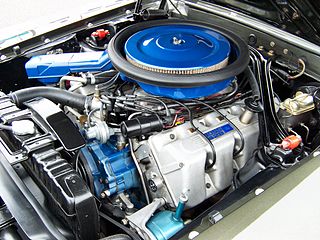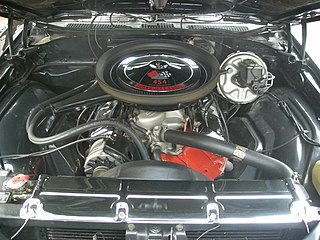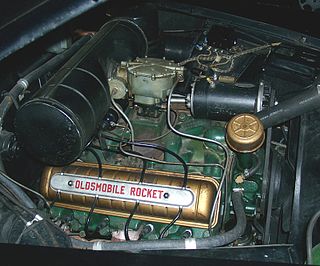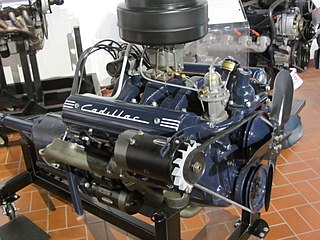
The Ford 385 engine family is a series of big-block V8 engines designed and manufactured by Ford Motor Company. The family derives its name from the 3.85-inch (98 mm) crankshaft stroke of the 460 cubic-inch V8 introduced in 1968. A 429 cu in (7.0 L) version was also introduced the same year, with a 370 cu in (6.1 L) variant appearing in 1977.

The Ford small-block is a series of 90° overhead valve small-block V8 automobile engines manufactured by the Ford Motor Company from July 1961 to December 2000.
The Y-block engine is a family of overhead valve V8 automobile engines produced by Ford Motor Company. The engine is well known and named for its deep skirting, which causes the engine block to resemble a Y. It was introduced in 1954 as a more modern replacement for the outdated side-valved Ford Flathead V8 and was used in a variety of Ford vehicles through 1964.

The LA engine is a family of overhead-valve small-block 90° V-configured gasoline engines built by Chrysler Corporation between 1964 and 2003. A replacement of the Chrysler A engine, they were factory-installed in passenger vehicles, trucks and vans, commercial vehicles, marine and industrial applications. Their combustion chambers are wedge-shaped, rather than polyspheric, as in the A engine, or hemispheric in the Chrysler Hemi. LA engines have the same 4.46 in (113 mm) bore spacing as the A engines.

The General Motors LS-based small-block engines are a family of V8 and V6 engines designed and manufactured by American automotive company General Motors. First introduced in 1997, the family is a continuation of the earlier first- and second-generation Chevrolet small-block engine, of which over 100 million have been produced altogether, and is also considered to be one of the most popular V8 engines ever. Spanning three generations, a new, sixth generation is expected to enter production soon. Various small-block V8s were and still are available as crate engines.

The Chevrolet "big block" engine is a term for a series of large-displacement, naturally-aspirated, 90°, overhead valve, gasoline-powered, V8 engines; that were developed and produced by the Chevrolet Division of General Motors, from the 1950s until present.

The Chevrolet small-block engine is a series of gasoline-powered V8 automobile engines, produced by the Chevrolet division of General Motors between 1954 and 2003, using the same basic engine block. Referred to as a "small-block" for its size relative to the physically much larger Chevrolet big-block engines, the small block family spanned from 262 cu in (4.3 L) to 400 cu in (6.6 L) in displacement. Engineer Ed Cole is credited with leading the design for this engine. The engine block and cylinder heads were cast at Saginaw Metal Casting Operations in Saginaw, Michigan.

The Rover V8 engine is a compact OHV V8 internal combustion engine with aluminium cylinder block and cylinder heads, originally designed by General Motors and later re-designed and produced by Rover in the United Kingdom. It has been used in a wide range of vehicles from Rover and other manufacturers since its British debut in 1967.

The Essex V6 is a 90° V6 engine family built by the Ford Motor Company at the Essex Engine Plant in Windsor, Ontario, Canada. This engine is unrelated to Ford's British Essex V6. Introduced in 1982, versions of the Essex V6 engine family were used in subcompact through to large cars, vans, minivans, and some pickup trucks. The Essex V6 was last used in the 2008 regular-cab F-150, after which it was succeeded by a version of the Ford Cyclone engine. An industrial version of the engine was available until 2015.

Power Stroke, also known as Powerstroke or PowerStroke, is the name used by a family of diesel engines for trucks produced by Ford Motor Company and Navistar International for Ford products since 1994. Along with its use in the Ford F-Series, applications include the Ford E-Series, Ford Excursion, and Ford LCF commercial truck. The name was also used for a diesel engine used in South American production of the Ford Ranger.

The Oldsmobile V8, also referred to as the Rocket, is a series of engines that was produced by Oldsmobile from 1949 until 1990. The Rocket, along with the 1949 Cadillac V8, were the first post-war OHV crossflow cylinder head V8 engines produced by General Motors. Like all other GM divisions, Olds continued building its own V8 engine family for decades, adopting the corporate Chevrolet 350 small-block and Cadillac Northstar engine only in the 1990s. All Oldsmobile V8s were manufactured at plants in Lansing, Michigan while the engine block and cylinder heads were cast at Saginaw Metal Casting Operations.

The term Cadillac V8 may refer to any of a number of V8 engines produced by the Cadillac Division of General Motors since it pioneered the first such mass-produced engine in 1914.

The Ford flathead V8 is a V8 engine with a flat cylinder head designed by the Ford Motor Company and built by Ford and various licensees. During the engine's first decade of production, when overhead-valve engines were used by only a small minority of makes, it was usually known simply as the Ford V‑8, and the first car model in which it was installed, the Model 18, was often called simply the "Ford V-8", after its new engine. Although the V8 configuration was not new when the Ford V8 was introduced in 1932, the latter was a market first in the respect that it made an 8-cylinder affordable and a V engine affordable to the emerging mass market consumer for the first time. It was the first independently designed and built V8 engine produced by Ford for mass production, and it ranks as one of the company's most important developments. A fascination with ever-more-powerful engines was perhaps the most salient aspect of the American car and truck market for a half century, from 1923 until 1973. The engine was intended to be used for big passenger cars and trucks; it was installed in such until 1953, making the engine's 21-year production run for the U.S. consumer market longer than the 19-year run of the Ford Model T engine for that market. The engine was on Ward's list of the 10 best engines of the 20th century. It was a staple of hot rodders in the 1950s, and it remains famous in the classic car hobbies even today, despite the huge variety of other popular V8s that followed.
The Ford Motor Company produced straight-six engines from 1906 until 1908 and from 1941 until 2016. In 1906, the first Ford straight-six was introduced in the Model K. The next was introduced in the 1941 Ford. Ford continued producing straight-six engines for use in its North American vehicles until 1996, when they were discontinued in favor of more compact V6 designs.
Ford developed the MEL ("Mercury-Edsel-Lincoln") engine series as the replacement for the Lincoln Y-block V8 engine for use in large passenger car applications. These engines were produced in Lima, Ohio at Ford's Lima Engine plant. They were in turn replaced by the 385 series engines.

The AMC V8 may refer to either of two distinct OHV V8 engine designs that were developed and manufactured by American Motors Corporation (AMC). The engines were used in cars and trucks by AMC, Kaiser, and International Harvester as well as in marine and stationary applications.

The Chrysler Hemi engines, known by the trademark Hemi or HEMI, are a series of American V8 gasoline engines built by Chrysler with overhead valve hemispherical combustion chambers. Three different types of Hemi engines have been built by Chrysler for automobiles: the first from 1951 to 1958, the second from 1964 to 1971, and the third from 2003 to 2024. Although Chrysler is most identified with the use of "Hemi" as a marketing term, many other auto manufacturers have incorporated similar designs. The engine block and cylinder heads were cast and manufactured at Indianapolis Foundry.
The Ford Super Duty engine is a range of V8 engines that were manufactured by Ford Motor Company. Introduced in 1958, the Super Duty engines replaced the Lincoln Y-block V8.

The Ford B series is a bus chassis that was manufactured by the Ford Motor Company. Produced across six generations from 1948 to 1998, the B series was a variant of the medium-duty Ford F series. As a cowled-chassis design, the B series was a bare chassis aft of the firewall, intended for bodywork from a second-stage manufacturer. While primarily used for school bus applications in the United States and Canada, the chassis was exported worldwide to manufacturers to construct bus bodies for various uses.















